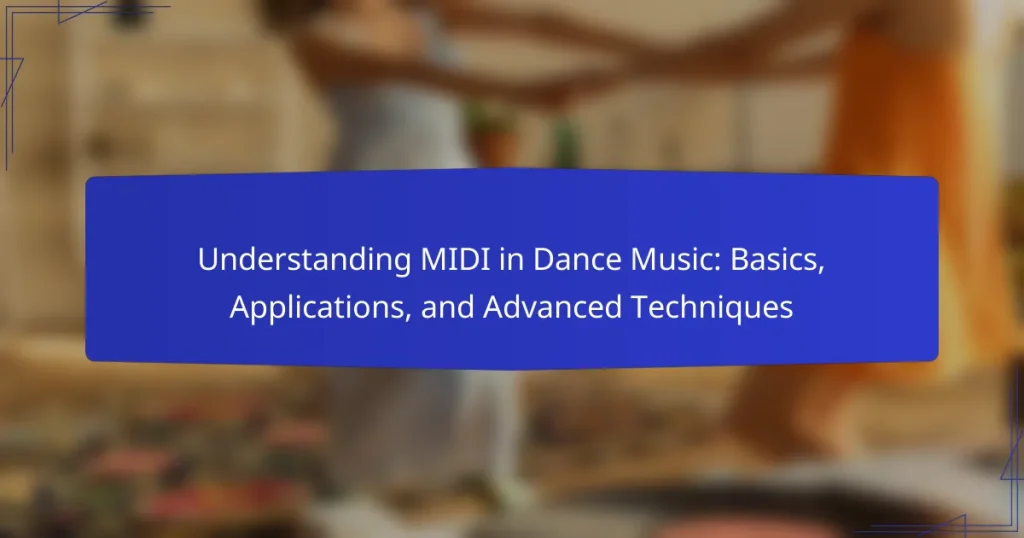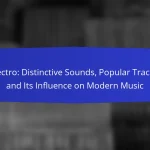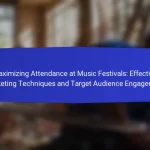MIDI, or Musical Instrument Digital Interface, is a technical standard enabling communication between electronic musical instruments and computers, transmitting information about notes, timing, and dynamics without audio signals. This article explores the role of MIDI in dance music, highlighting its applications in music production, including sequencing, real-time performance control, and automation. It also discusses advanced techniques such as MIDI effects processing, which enhance sound design and rhythmic variations. The versatility and collaborative capabilities of MIDI have made it an essential tool for both amateur and professional music producers in the dance music genre.
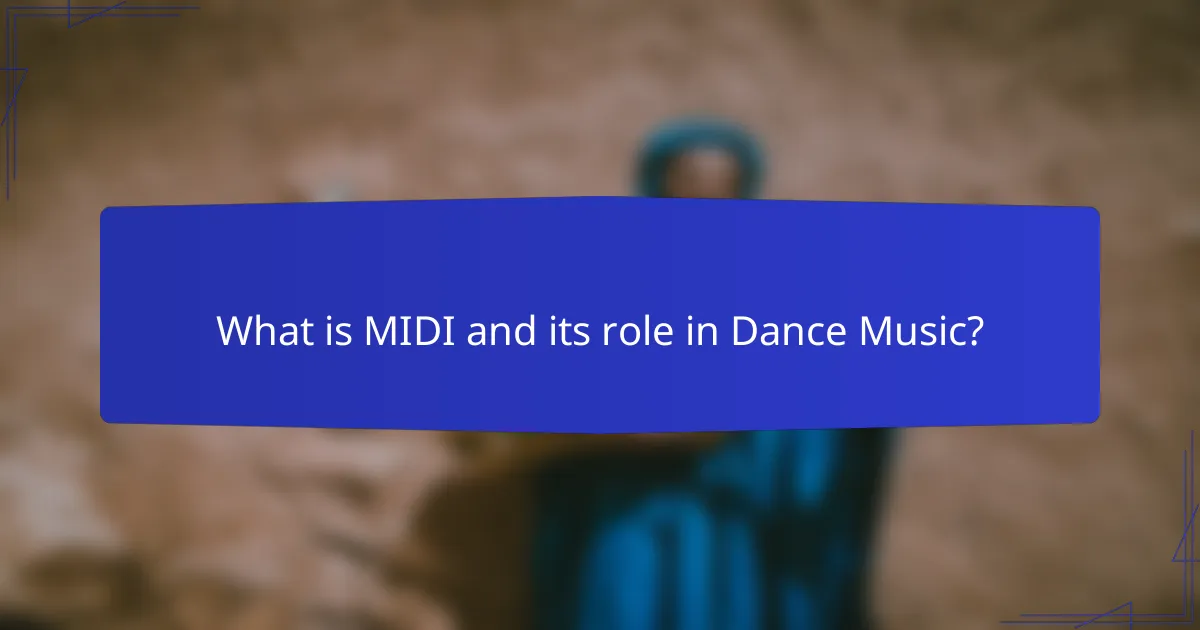
What is MIDI and its role in Dance Music?
MIDI stands for Musical Instrument Digital Interface. It is a technical standard that allows electronic musical instruments and computers to communicate. MIDI transmits information about notes, timing, and dynamics but does not carry audio signals. This enables artists to create and manipulate music digitally.
In dance music, MIDI plays a crucial role in music production. It allows producers to sequence and edit musical notes with precision. Producers can use MIDI to control synthesizers and drum machines, creating complex rhythms and melodies. This flexibility enhances creativity in the production process.
MIDI also facilitates collaboration among musicians. Artists can share MIDI files, allowing others to modify or add to the music. This has led to innovative sounds and styles in dance music. Many popular dance tracks are built using MIDI sequencing techniques.
The versatility of MIDI has contributed to its widespread use in the dance music genre. It remains a fundamental tool for both amateur and professional music producers.
How does MIDI function in the context of music production?
MIDI functions in music production by transmitting digital signals that represent musical information. It allows instruments and devices to communicate with each other. MIDI data includes notes, velocity, pitch, and control changes. This data does not contain audio but rather instructions for sound generation. Producers can use MIDI to create, edit, and manipulate music effortlessly. MIDI enables the use of virtual instruments and synthesizers in digital audio workstations (DAWs). It supports automation and precise timing, enhancing the production process. MIDI’s versatility makes it essential for composing, arranging, and performing music.
What are the key components of MIDI technology?
The key components of MIDI technology include MIDI messages, MIDI channels, and MIDI devices. MIDI messages transmit performance data, such as note on/off, pitch bend, and control changes. These messages are sent over MIDI channels, which allow multiple instruments to communicate without interference. MIDI devices consist of hardware and software that send, receive, and process MIDI data. Common MIDI devices include keyboards, synthesizers, and computers. MIDI technology operates at a standard speed of 31.25 kbps, enabling real-time communication between devices. The MIDI protocol was established in 1983, ensuring compatibility across different manufacturers.
How does MIDI communicate between devices?
MIDI communicates between devices using a series of digital messages. These messages transmit information about musical notes, control signals, and timing. The communication occurs over various physical connections, such as USB or traditional 5-pin DIN connectors. Each MIDI device sends and receives data through channels, typically ranging from 1 to 16.
When a note is played on a MIDI keyboard, it sends a “Note On” message to the connected device. This message includes details like the note number and velocity. The receiving device interprets this message to produce the corresponding sound. MIDI also supports “Control Change” messages, which adjust parameters like volume or modulation.
MIDI operates at a standard baud rate of 31,250 bits per second. This speed allows for real-time communication between devices without noticeable latency. The versatility of MIDI makes it a crucial component in modern music production and performance setups.
Why is MIDI important for dance music producers?
MIDI is important for dance music producers because it allows for precise control over musical elements. It facilitates the creation, editing, and playback of music using digital instruments. Producers can manipulate notes, rhythms, and dynamics easily. MIDI data is lightweight, making it efficient for storage and processing. This technology enables real-time performance adjustments during live shows. MIDI also supports a wide range of virtual instruments and effects. It has become a standard in music production, ensuring compatibility across various software and hardware. The versatility of MIDI allows for complex compositions without needing extensive recording equipment.
What advantages does MIDI offer in music creation?
MIDI offers several advantages in music creation. It allows for precise control over musical elements. Musicians can easily edit notes, timing, and velocity. MIDI data is lightweight and easily transferable between devices. It enables the use of various virtual instruments and sound libraries. MIDI supports real-time performance and recording. It enhances collaboration by allowing multiple users to work on a project simultaneously. MIDI’s versatility allows integration with both hardware and software systems. These features make MIDI a powerful tool for modern music production.
How does MIDI enhance creativity and workflow?
MIDI enhances creativity and workflow by providing musicians with versatile tools for composition and arrangement. It allows for easy manipulation of musical notes and parameters. Musicians can edit, rearrange, and layer sounds quickly. This flexibility fosters experimentation and innovation in music creation. MIDI also enables real-time performance adjustments, enhancing spontaneity. Furthermore, it integrates seamlessly with digital audio workstations (DAWs). This integration streamlines the production process, reducing time spent on technical tasks. Studies show that MIDI’s capabilities can lead to increased productivity and creativity in music projects.
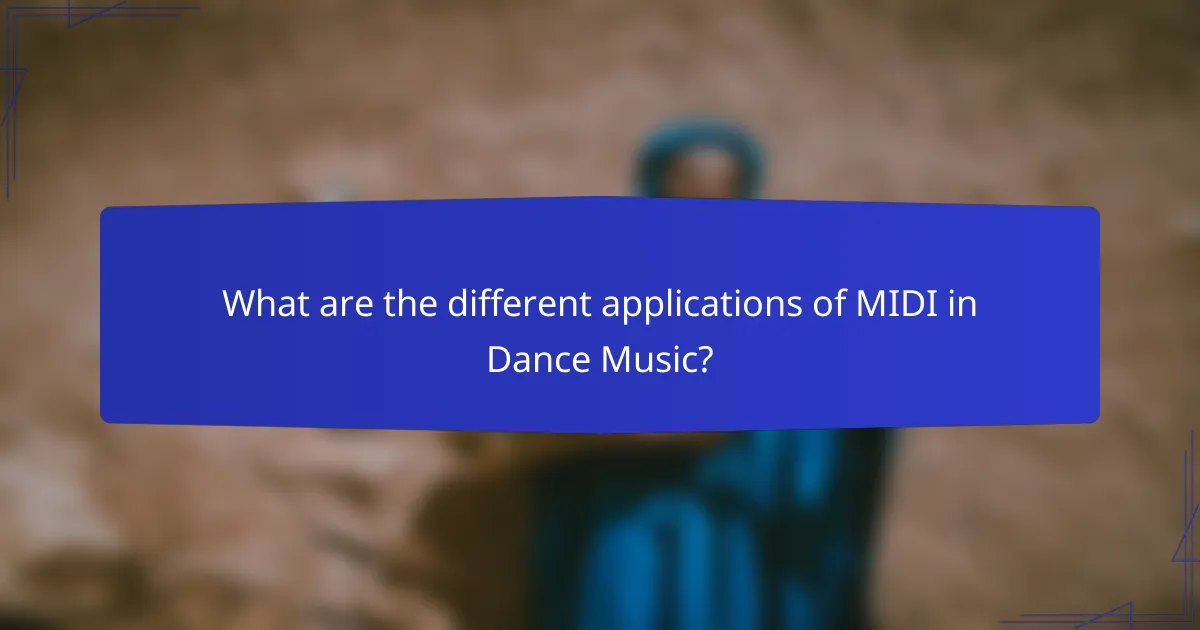
What are the different applications of MIDI in Dance Music?
MIDI is used in dance music for various applications. One primary application is sequencing, which allows producers to arrange musical notes and rhythms. MIDI enables real-time performance control, facilitating live adjustments during performances. It also supports virtual instruments, enabling users to create sounds without physical instruments. MIDI facilitates automation, allowing for dynamic changes in volume, effects, and other parameters. Additionally, MIDI is utilized for triggering samples and loops, enhancing the production process. Its compatibility with various software makes it essential for music production. Overall, MIDI’s versatility significantly impacts dance music creation and performance.
How is MIDI used in live performances?
MIDI is used in live performances to control musical instruments and software. It allows musicians to send data signals to synthesizers, drum machines, and computers. This enables real-time manipulation of sounds during a performance. MIDI can trigger samples, adjust parameters, and synchronize multiple devices. Musicians can also use MIDI controllers to play notes and control effects. The versatility of MIDI enhances live shows by allowing complex arrangements. Many artists incorporate MIDI for seamless transitions and dynamic performances. This technology has become a standard in modern live music setups.
What equipment is commonly used for MIDI in live settings?
MIDI equipment commonly used in live settings includes MIDI controllers, synthesizers, and audio interfaces. MIDI controllers allow musicians to trigger sounds and control software instruments. They often feature pads, knobs, and sliders for performance flexibility. Synthesizers generate sounds based on MIDI input. They can be hardware or software-based. Audio interfaces connect MIDI devices to computers, ensuring low-latency performance. Additionally, laptops running DAWs (Digital Audio Workstations) are essential for managing MIDI tracks. These tools enable seamless integration of MIDI in live performances, enhancing the overall musical experience.
How does MIDI facilitate real-time music manipulation?
MIDI facilitates real-time music manipulation by transmitting digital signals that represent musical notes and control data. This allows musicians to manipulate sound parameters instantly during performance. MIDI messages can convey information about pitch, velocity, and duration of notes. Additionally, they can control effects, volume, and other aspects of sound in real time. The protocol enables multiple devices to communicate seamlessly, allowing for complex arrangements. MIDI’s low latency ensures that changes occur without noticeable delay. This responsiveness is crucial for live performances and studio sessions. MIDI’s versatility supports various instruments and software, making it a fundamental tool in modern music production.
What role does MIDI play in music composition and arrangement?
MIDI plays a crucial role in music composition and arrangement by allowing musicians to create, edit, and manipulate musical data digitally. It enables the control of various instruments and sounds through a standardized protocol. MIDI facilitates the arrangement of complex compositions by providing a visual representation of musical notes and rhythms. This technology allows for easy experimentation with different sounds and arrangements without the need for physical instruments. MIDI data can be easily edited, enabling composers to refine their work efficiently. Additionally, MIDI supports the integration of hardware and software instruments, enhancing creative possibilities. The ability to quantize and adjust timing in MIDI tracks allows for precise rhythmic control. Overall, MIDI streamlines the composition process and expands creative options for musicians.
How can MIDI be utilized for arranging tracks?
MIDI can be utilized for arranging tracks by allowing musicians to create, edit, and organize musical elements digitally. It enables the manipulation of note data, such as pitch, velocity, and timing. Musicians can layer multiple MIDI tracks, each representing different instruments or sounds. MIDI sequencing software provides tools for arranging these tracks into a cohesive structure. This allows for easy adjustments to the arrangement, such as changing the order of sections or adding effects. The non-destructive nature of MIDI means changes can be made without losing original data. Moreover, MIDI supports automation of parameters, enhancing dynamic control throughout the arrangement. This flexibility makes MIDI an essential tool in modern music production.
What software tools are best for MIDI composition?
The best software tools for MIDI composition include Ableton Live, FL Studio, Logic Pro, and Cubase. Ableton Live is known for its user-friendly interface and real-time performance capabilities. FL Studio offers a powerful piano roll for MIDI editing and a wide range of plugins. Logic Pro is favored for its extensive sound library and MIDI capabilities, making it ideal for music production. Cubase is recognized for its advanced MIDI editing features and professional-grade audio capabilities. These tools are widely used in the industry, providing essential features for creating and editing MIDI compositions efficiently.
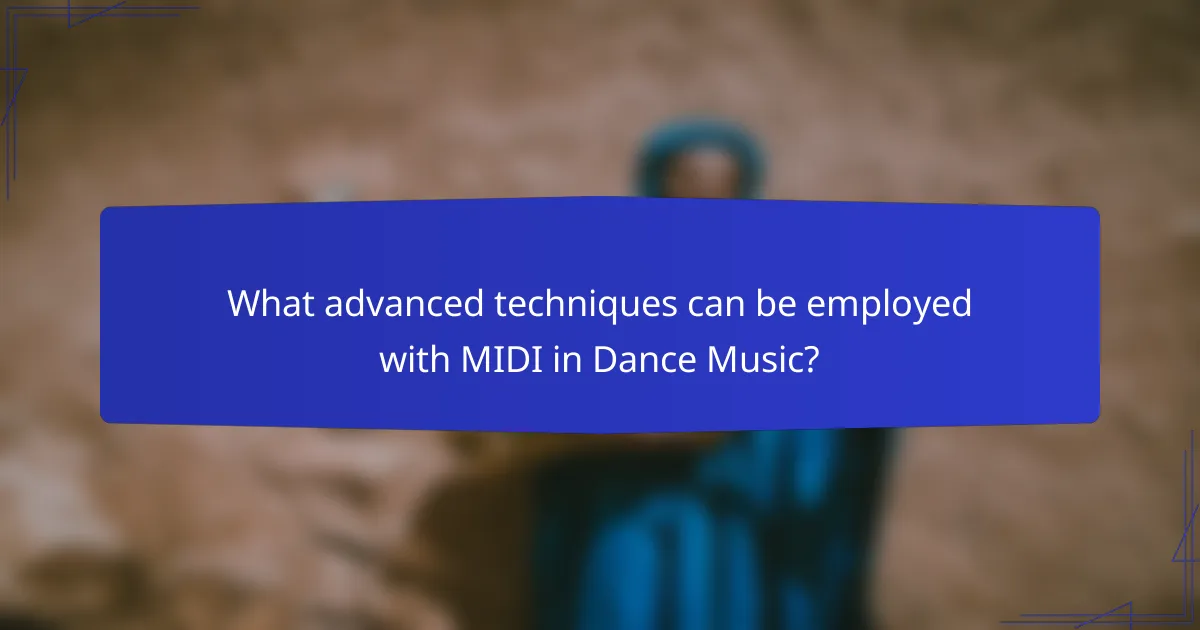
What advanced techniques can be employed with MIDI in Dance Music?
Advanced techniques that can be employed with MIDI in dance music include MIDI sequencing, automation, and MIDI effects processing. MIDI sequencing allows for precise arrangement and manipulation of musical elements within a track. Automation can control various parameters over time, such as volume, panning, and effects, enhancing the dynamic range of the music. MIDI effects processing includes using tools like arpeggiators and chord generators to create complex patterns and harmonies. These techniques enable producers to achieve intricate sound design and rhythmic variations, essential in dance music production.
How can MIDI be utilized for sound design?
MIDI can be utilized for sound design by sending digital signals that control synthesizers and software instruments. This allows sound designers to manipulate various parameters like pitch, velocity, and modulation. MIDI data can trigger samples and control effects in real-time. It enables the creation of complex arrangements by sequencing multiple instruments. Sound designers can use MIDI to automate changes in sound parameters over time. This flexibility allows for dynamic soundscapes and intricate textures. MIDI also supports various controllers, enhancing tactile interaction with sound design tools. Overall, MIDI is essential for modern sound design, facilitating creativity and precision.
What are some creative MIDI effects and processing techniques?
Creative MIDI effects and processing techniques include arpeggiators, chord generators, and MIDI effects racks. Arpeggiators transform single notes into rhythmic patterns. They allow musicians to create complex sequences effortlessly. Chord generators enable the creation of full chords from single notes. This technique enhances harmonic richness in compositions. MIDI effects racks combine multiple effects for unique sound manipulation. They can include pitch shifting, note randomization, and velocity modulation. These techniques encourage experimentation and can lead to innovative musical ideas. Using these methods, producers can expand their sonic palette significantly.
How can MIDI control synthesizers and samplers effectively?
MIDI can effectively control synthesizers and samplers by transmitting digital signals that dictate musical parameters. This communication allows for precise manipulation of sound through note information, velocity, and control changes. Synthesizers respond to MIDI note messages by generating corresponding pitches. Samplers utilize MIDI to trigger specific audio samples based on the received note data. Additionally, MIDI control change messages can modify parameters like filter cutoff and modulation depth in real-time. The use of MIDI allows for synchronization between multiple devices, enhancing performance capabilities. MIDI’s versatility facilitates complex arrangements and live performances, making it essential in modern music production.
What are some common challenges faced when using MIDI?
Common challenges faced when using MIDI include latency issues, compatibility problems, and limited expressiveness. Latency can cause a noticeable delay between playing a note and hearing the sound. This can disrupt the timing in performances and recordings. Compatibility issues arise when different devices or software do not communicate effectively. This can lead to difficulties in integrating various hardware and software setups. Limited expressiveness is a challenge since MIDI primarily transmits note on/off information. This can restrict the dynamic range and nuances in musical performance. Additionally, users may encounter a steep learning curve with MIDI programming and software. Understanding MIDI protocols and settings can be complex for beginners. These challenges can hinder the overall user experience in music production.
How can latency issues be minimized in MIDI setups?
To minimize latency issues in MIDI setups, utilize a high-quality audio interface. A reliable audio interface reduces the time it takes for MIDI signals to be processed. Additionally, adjusting the buffer size in the digital audio workstation (DAW) can help. Lower buffer sizes decrease latency but may increase the risk of audio dropouts.
Using a direct monitoring feature on the audio interface can also help musicians hear their performance in real-time. Keeping the MIDI controller and DAW software up-to-date ensures optimal performance and compatibility.
Furthermore, connecting MIDI devices via USB instead of traditional MIDI cables can reduce latency. Optimizing the computer’s performance by closing unnecessary applications also contributes to lower latency. These methods collectively enhance the responsiveness of MIDI setups in dance music production.
What troubleshooting tips can help resolve MIDI connectivity problems?
Check all MIDI connections to ensure they are secure. Loose cables can interrupt communication. Restart your MIDI devices to reset connections. This often resolves temporary issues. Update your MIDI drivers to the latest version. Outdated drivers can cause compatibility problems. Verify that your software recognizes the MIDI device. Sometimes, software settings may need adjustment. Test with different USB ports if using a USB MIDI interface. Some ports may not provide sufficient power. Use a MIDI monitor application to diagnose signal flow. This can help identify where the issue lies.
What best practices should be followed when working with MIDI in Dance Music?
Use quantized timing to ensure precise note placement in MIDI tracks. This practice enhances the rhythm and groove of dance music. Adjust the quantization settings to suit the style of the track. For example, use swing settings for a more human feel.
Utilize MIDI controllers for real-time input. This method allows for expressive performances. Controllers can add dynamics that enhance the overall sound.
Incorporate layering of MIDI tracks. Layering adds depth and richness to the arrangement. Use different instruments to create a fuller sound.
Regularly edit MIDI velocities. Adjusting velocities helps create a more natural performance. It prevents notes from sounding robotic and lifeless.
Organize MIDI tracks clearly in your DAW. Clear labeling and color-coding improve workflow efficiency. This organization helps in navigating complex projects.
Experiment with MIDI effects and plugins. These tools can transform sounds and add unique characteristics. Effects like arpeggiators can inspire new musical ideas.
Finally, save MIDI templates for future projects. Templates streamline the production process. They allow for efficient setup in new sessions.
MIDI, or Musical Instrument Digital Interface, is a crucial technology in dance music production that allows electronic instruments and computers to communicate by transmitting musical information without audio signals. This article explores the fundamental aspects of MIDI, including its role in music production, key components, and how it facilitates real-time manipulation during live performances. Additionally, it delves into the various applications of MIDI in dance music, advanced techniques for sound design, and best practices for optimizing MIDI workflows. By examining these topics, the article provides a comprehensive understanding of MIDI’s significance and versatility in the dance music genre.
